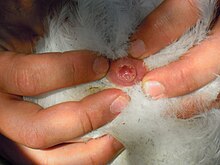Cloaca
In animal anatomy, a cloaca /kloʊˈeɪkə/ kloh-AY-kə (plural cloacae /kloʊˈeɪsiː/ kloh-AY-see) is the posterior orifice that serves as the only opening for the digestive, reproductive, and urinary tracts (if present) of certain animals, opening at the vent. All amphibians, birds, reptiles, and a few mammals (monotremes, tenrecs, golden moles, and marsupial moles) have this orifice, from which they excrete both urine and feces; this is in contrast to most placental mammals, which have two or three separate orifices for evacuation. Excretory systems with analogous purpose in certain invertebrates are also sometimes referred to as cloacae.
The cloacal region is also often associated with a secretory organ, the cloacal gland, which has been implicated in the scent-marking behavior of some reptiles, amphibians, and monotremes.
Etymology
The word comes from Latin, and means sewer derived from cluō, which meant "cleanse".
Birds

Birds reproduce using their cloaca; this occurs during a cloacal kiss in most birds. Birds that mate using this method touch their cloacae together, in some species for only a few seconds, sufficient time for sperm to be transferred from the male to the female.[1] The reproductive system must be re-engorged prior to the mating season of each species. Such regeneration usually takes about a month. Birds generally produce one batch of eggs per year, but they will produce another if the first is taken away. For some birds, such as ostriches, cassowaries, kiwi, geese, and some species of swans and ducks, the males do not use the cloaca for reproduction, but have a phallus. In those, the penis helps ensure water does not wash away the male's sperm during copulation.[citation needed]
One study[2] has looked into birds that use their cloaca for cooling.[3]
Fish
Among fish, a true cloaca is present only in elasmobranchs (sharks and rays) and lobe-finned fishes. In lampreys and in some ray-finned fishes, part of the cloaca remains in the adult to receive the urinary and reproductive ducts, although the anus always opens separately. In chimaeras and most teleosts, however, all three openings are entirely separated.[4]
Mammals
With a few exceptions noted below, mammals have no cloacae. Even in those that have one, the cloaca is partially subdivided into separate regions for the anus and urethra.
Monotremes
The monotremes (egg-laying mammals) possess a true cloaca.
Marsupials

In marsupials (and a few birds), the genital tract is separate from the anus, but a trace of the original cloaca does remain externally.[4] This is one of the features of marsupials (and monotremes) that suggest their basal nature, as the amniotes from which mammals evolved possessed a cloaca, and the earliest animals to diverge into the mammalian class would most likely have had this feature, too.
Unlike other marsupials, marsupial moles have a true cloaca,[5] a fact that has been argued against a marsupial identity for these mammals.[6][7]
Placentals
Most adult placental mammals have no remaining trace of the cloaca. In the embryo, the embryonic cloaca divides into a posterior region that becomes part of the anus, and an anterior region that has different fates depending on the sex of the individual: in females, it develops into the vestibule that receives the urethra and vagina, while in males it forms the entirety of the penile urethra.[4] However, the tenrecs and golden moles, small placental mammals native to Africa, as well as some shrews retain a cloaca as adults.[8]
Being placental animals, humans only have an embryonic cloaca, which is split up into separate tracts during the development of the urinary and reproductive organs. However, a few human congenital disorders result in persons being born with a cloaca, including persistent cloaca and sirenomelia (mermaid syndrome).
Reptiles
Some species have modified cloacae for increased gas exchange (see Reptile respiration). This is where reproductive activity occurs.
Cloacal respiration in animals
Some turtles, especially those specialized in diving, are highly reliant on cloacal respiration during dives.[9] They accomplish this by having a pair of accessory air bladders connected to the cloaca which can absorb oxygen from the water.[10] Various fish, as well as polychaete worms and even crabs, are specialized to take advantage of the constant flow of water through the cloacal respiratory tree of sea cucumbers while simultaneously gaining the protection of living within the sea cucumber itself. At night, many of these species emerge from the anus of the sea cucumber in search of food.[11]
References
- ^ Lynch, Wayne (2007). "The Cloacal Kiss". Owls of the United States and Canada. JHU Press. p. 151. ISBN 0-8018-8687-2.
- ^ Hoffman, Ty C. M.; Walsberg, Glenn E.; DeNardo, Dale F. (2007). "Cloacal evaporation: an important and previously undescribed mechanism for avian thermoregulation". The Journal of Experimental Biology. 210 (5): 741–9. doi:10.1242/jeb.02705. PMID 17297135.
- ^ Hager, Yfke (2007). "Cloacal Cooling". The Journal of Experimental Biology. 210 (5): i. doi:10.1242/jeb.02737.
- ^ a b c Romer, Alfred Sherwood; Parsons, Thomas S. (1977). The Vertebrate Body. Philadelphia, PA: Holt-Saunders International. pp. 396–399. ISBN 0-03-910284-X.
- ^ Gadow, H. On the systematic position of Notoryctes typhlops. Proc. Zool. Soc. London 1892, 361–370 (1892).
- ^ Riedelsheimer, B., Unterberger, P., Künzle, H. and U. Welsch. 2007. Histological study of the cloacal region and associated structures in the hedgehog tenrec Echinops telfairi. Mammalian Biology 72(6): 330-341.
- ^ On Dryolestid affinities [1] [full citation needed]
- ^ Biological Reviews - Cambridge Journals
- ^ Dunson, William A. (1960). "Aquatic Respiration in Trionyx spinifer asper". Herpetologica. 16 (4). Herpetologists' League: 277–83. JSTOR 3889486.
- ^ The Straight Dope - Is it true turtles breathe through their butts?
- ^ Aquarium Invertebrates by Rob Toonen, Ph.D.
